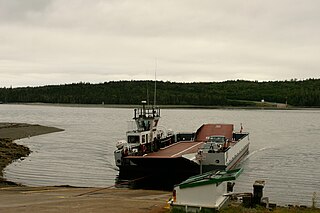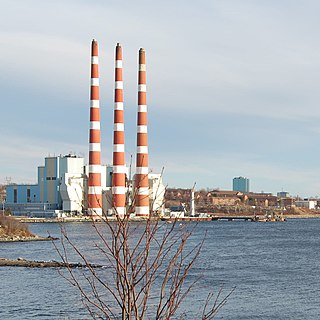Related Research Articles

Liquefied natural gas (LNG) is natural gas (predominantly methane, CH4, with some mixture of ethane, C2H6) that has been cooled down to liquid form for ease and safety of non-pressurized storage or transport. It takes up about 1/600th the volume of natural gas in the gaseous state at standard conditions for temperature and pressure.

Country Harbour is a rural community in Guysborough County, Nova Scotia, Canada. The community is situated on a large deep natural harbour of the same name and is located along the province's Eastern Shore close to Canso, Nova Scotia.

Emera Incorporated is a publicly traded Canadian multinational energy holding company based in Halifax, Nova Scotia. Created in 1998 during the privatization of Nova Scotia Power, a provincial Crown corporation, Emera now invests in regulated electricity generation as well as transmission and distribution across North America and the Caribbean.
Enbridge Inc. is a Canadian multinational pipeline and energy company headquartered in Calgary, Alberta, Canada. Enbridge owns and operates pipelines throughout Canada and the United States, transporting crude oil, natural gas, and natural gas liquids, and also generates renewable energy. Enbridge's pipeline system is the longest in North America and the largest oil export pipeline network in the world. Its crude oil system consists of 28,661 kilometres of pipelines. Its 38,300 kilometre natural gas pipeline system connects multiple Canadian provinces, several US states, and the Gulf of Mexico. The company was formed by Imperial Oil in 1949 as the Interprovincial Pipe Line Company Limited to transport Alberta oil to refineries. Over time, it has grown through acquisition of other existing pipeline companies and the expansion of their projects.
The Sable Offshore Energy Project (SOEP) is a consortium based in Halifax, Nova Scotia which explores for and produced natural gas near Sable Island on the edge of the Nova Scotian continental shelf in eastern Canada. SOEP produced between 400 and 500 million cubic feet (14,000,000 m3) of natural gas and 20,000 barrels (3,200 m3) of natural gas liquids daily until 2018.
Petroleum production in Canada is a major industry which is important to the overall economy of North America. Canada has the third largest oil reserves in the world and is the world's fourth largest oil producer and fourth largest oil exporter. In 2019 it produced an average of 750,000 cubic metres per day (4.7 Mbbl/d) of crude oil and equivalent. Of that amount, 64% was upgraded from unconventional oil sands, and the remainder light crude oil, heavy crude oil and natural-gas condensate. Most of the Canadian petroleum production is exported, approximately 600,000 cubic metres per day (3.8 Mbbl/d) in 2019, with 98% of the exports going to the United States. Canada is by far the largest single source of oil imports to the United States, providing 43% of US crude oil imports in 2015.

Heritage Gas Limited is a company that specializes in providing natural gas solutions to residential, commercial, and industrial customers. Based in Nova Scotia, Canada, Heritage Gas offers clean and reliable energy options for heating, cooking, and various other energy needs.
Goldboro is a Canadian rural community in Guysborough County, Nova Scotia. Located on the Eastern Shore along Route 316, Goldboro is approximately 16 kilometres west of the shire town of Guysborough.
The Halifax Regional Municipality (HRM) is a major generator of economic activity in Atlantic Canada.

Tufts Cove Generating Station is a Canadian electrical generating station located in the Dartmouth neighbourhood of Tufts Cove in Nova Scotia's Halifax Regional Municipality.

Guysborough, officially named the Municipality of the District of Guysborough, is a district municipality in Guysborough County, Nova Scotia, Canada. Statistics Canada classifies the district municipality as a municipal district.
Canada's early petroleum discoveries took place near population centres or along lines of penetration into the frontier.
Sources include: Dow Jones (DJ), New York Times (NYT), Wall Street Journal (WSJ), and the Washington Post (WP).

Offshore drilling for oil and gas on the Atlantic coast of the United States took place from 1947 to the early 1980s. Oil companies drilled five wells in Atlantic Florida state waters and 51 exploratory wells on federal leases on the outer continental shelf of the Atlantic coast. None of the wells were completed as producing wells. All the leases have now reverted to the government.
The Brunswick Pipeline is a natural gas transmission pipeline in the Canadian province of New Brunswick.
The Shelburne Basin Venture Exploration Drilling Project is an exploratory hydrocarbon drilling program by Shell Canada, the subsidiary of Shell plc in the Shelburne basin approximately 250 kilometers offshore, South of Halifax, Nova Scotia. Shell Canada has proposed up to seven exploration wells within six exploration licenses over a four-year period from 2015 to 2019. Shell carried out a 3D Wide Azimuth seismic survey in 2013, and a seabed survey in the same offshore area in 2014. In June 2015, the Canadian Environmental Assessment Agency published its environmental assessment. The Canada-Nova Scotia Offshore Petroleum Board (CNSOPB) approved the project on October 20, 2015. In September 2016, one of the non-operating partners, Suncor, wrote off its investment in the first exploration well when the operator, Shell, reported that the well was noncommercial.

Fracking in Canada was first used in Alberta in 1953 to extract hydrocarbons from the giant Pembina oil field, the biggest conventional oil field in Alberta, which would have produced very little oil without fracturing. Since then, over 170,000 oil and gas wells have been fractured in Western Canada. Fracking is a process that stimulates natural gas or oil in wellbores to flow more easily by subjecting hydrocarbon reservoirs to pressure through the injection of fluids or gas at depth causing the rock to fracture or to widen existing cracks.

Natural gas was the United States' largest source of energy production in 2016, representing 33 percent of all energy produced in the country. Natural gas has been the largest source of electrical generation in the United States since July 2015.
In addition to terrestrial oil wells, Canada also extracts oil via offshore drilling.
References
- ↑ Daily News (Halifax, NS), "Oil still the way to go", December 10, 2000